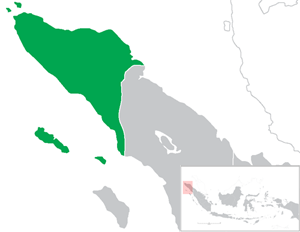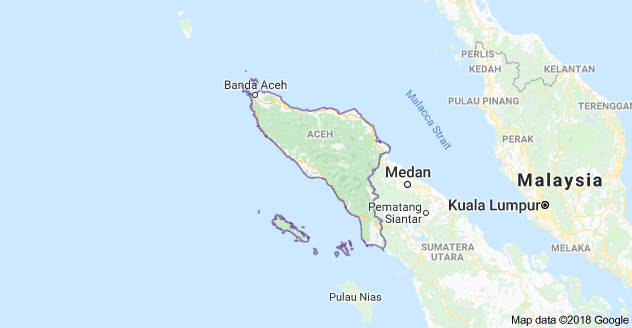Aceh - Indonesia
Aceh is a province in Indonesia, Aceh is located at the northern tip of the island of Sumatra and is the most western province in Indonesia. The capital is Banda Aceh. The population of the province is about 4,500,000 inhabitants. It is close to the Andaman and Nicobar Islands of India and is separated by the Andaman Sea. Aceh is bordered by the Bay of Bengal to the north, the Indian Ocean to the west, the Malacca Strait in the east, and North Sumatra in the southeast and south.

Aceh is regarded as the starting place for the spread of Islam in Indonesia and an important role in the spread of Islam in Southeast Asia. At the beginning of the 17th century, the Sultanate of Aceh was the richest, strongest, and most prosperous state in the Strait of Malacca. Aceh's history is colored by political freedom and linked to foreigners, including former Dutch colonialists and the Indonesian government. When compared to other provinces, Aceh is a very conservative region (upholding religious values). The percentage of Muslim population is the highest in Indonesia and they live according to Islamic shariah. Depending on the majors in Indonesia, Aceh has autonomy which is the basis for historical reasons.
Aceh has abundant natural resources, including petroleum and natural gas. The results of natural gas analysis is the largest in the world. Aceh is also famous for its forests on the Bukit Barisan hill from Kutacane in Southeast Aceh to Ulu Masen in Aceh Jaya. A national park called Gunung Leuser National Park (TNGL) was established in Southeast Aceh.
Aceh is the land closest to the epicenter of the 2004 Indian Ocean earthquake. After the earthquake, tsunami waves hit most of the province's west coast. About 170,000 people died or disappeared from the disaster. This disaster also encouraged the creation of a peace agreement between the government of the Republic of Indonesia and the Free Aceh Movement (GAM).
The origin of the name
Aceh was first known as Aceh Darussalam (1511-1959), then Aceh Special Region (1959-2001), Nanggroë Aceh Darussalam (2001-2009), and last Aceh (2009-present). Previously, Aceh's name was usually written by Acheh, Atjeh, and Achin.

Prehistoric times
Clam hill from prehistoric times in Aceh Tamiang
Aceh has been inhabited by humans since the days of Mesolithic, as evidenced by the existence of Bukit Kerang site that is claimed as a relic of the era in Aceh Tamiang district. In addition to other sites called the Village Site Base has also been done excavations and successfully found artifacts relics from the times of Mesolitikum Sumatralith ax, human teeth fragments, rhinoceros bone, and some other simple equipment. In addition to the district of Aceh Tamiang, relics of prehistoric life in Aceh are also found in the Gayo highlands precisely in Ceruk Mendale and Ceruk Ujung Karang which is located around Lake Laut Tawar. The discovery of this prehistoric site reveals evidence of prehistoric human settlements that have been taking place here at about 7,400 to 5,000 years ago.
Tribes
Aceh has 13 indigenous tribes. The largest is the tribe of Aceh inhabiting coastal areas ranging from Langsa on the north east coast to Trumon on the south west coast. Other tribes are Gayo tribe, Gayo Lut tribe, Gayo Luwes tribe, Gayo Serbe So tribe who inhabit the mountainous region in central Aceh. There are also other tribes such as Aneuk Jamee in South Aceh, Singkil and Pakpak in Subulussalam, Singkil and Alas in Southeast Aceh, Kluet in South Aceh and Tamiang in Aceh Tamiang, and on Simeulue Island Sigulai Tribe.
The results of the 2000 population census show the following results: Aceh (50.32%), Java (15.87%), Gayo (11.46%), Alas (3.89%), Singkil (2.55%), Simeulue (2.47%), Batak (2.26%), Minangkabau (1.09%), others (10.09%), However the 2000 census was carried out when Aceh was in conflict, reaching less than half of Aceh's population at the time. The most serious problem in enumeration was found in the districts of Aceh Timur and Aceh Utara, and no data were collected from Pidie district. These three districts are districts with the majority of Acehnese tribes.
Language
The most widely used local language in Aceh is Aceh, which is spoken by ethnic Aceh along the Aceh coast and parts of Aceh. Other languages are Gayo language in central Aceh, Alas Language in Southeast Aceh, Aneuk Jamee in South Aceh, Singkil and Pakpak Language in Aceh Singkil, Kluet Language in South Aceh, Tamiang Malay in Aceh Tamiang, In northern Simeulue found Sigulai language and Lekon Language, while in south simeulue encountered Language Devayan, Haloban Language.
Religion
Main articles for this section are: Islam in Aceh and Christianity in Aceh
See also: Islamic criminal law in Aceh
Most of the population in Aceh adheres to Islam. Of the 13 indigenous tribes in Aceh only Nias tribes who are not all embraced Islam.
Another religion adopted by the population in Aceh is a Christian religion embraced by Batak settlers and some Chinese people who mostly have Hakka ethnicity. Others remained Confucian.
In addition, Aceh province has a distinctive feature compared to other provinces, because in this province Shariah Islam is applied to most of its citizens who embrace Islam, based on Law No.18 / 2001. The Acehnese intellectuals themselves are still debating whether what is enacted in Aceh is truly Shari'a or that it is only for political reasons. The reason that is also later mentioned is the concrete condition when it comes to politics, polemic among jumhur ulama about whether or not Islamic law can be produced post-prophetic in addition to the issue of the dualism of the flow in Islam, two major schools in the tradition of Islamic jurisprudence.
Art and culture
Main article for this section are: Aceh Culture
Aceh is a region rich in art and culture of other parts of Indonesia. Aceh has a variety of distinctive cultural arts such as dances, and other cultures such as:
- Meuseukee Eungkot (a tradition in the Aceh Barat area)
- Peusijuek (or Flour in Malay tradition)
Climate
As a region not far from the equator, the climate in Aceh is almost entirely tropical. On coastal areas the average air temperature is 26.9 ° C, the maximum air temperature reaches 32.5 ° C and a minimum of 22.9 ° C. The relative humidity of this area ranges between 70 and 80 percent. Between March and August Aceh experiences a dry season, this condition is influenced by the air masses of the Australian continent. While the rainy season lasts between September to February generated from the air mass of mainland Asia and the Pacific Ocean. Aceh has varying rainfall ranging from 1,500-2,500 mm per year.
Geography
The province of Aceh occupies the westernmost region on the island of Sumatra and the State of Indonesia, where the outermost point of the Unitary State of the Republic of Indonesia is located on Rondo Island, while the kilometer of Zero Indonesia is on Weh Island. Geographically, Aceh is located between 2 ° - 6 ° north latitude and 95 ° - 98 ° south latitude with an average height of 125 meters above sea level. The boundary borders of Aceh, the north and the east are bordered by the Malacca Strait, the south is the only land border with the Province of North Sumatra and the west with the Indian Ocean.
Area of Aceh Province 5,677,081 ha, with forest as the widest area reaching 2,290,874 ha, followed by plantation area of 800,553 ha. While the industrial land has the smallest area of 3,928 ha. The scope of Aceh consists of 119 islands, 35 mountains and 73 major rivers.